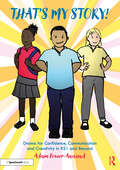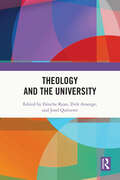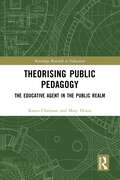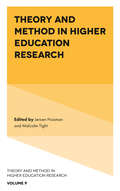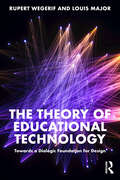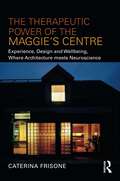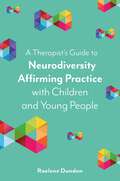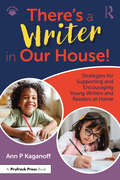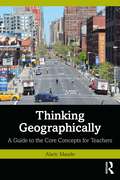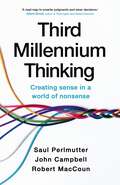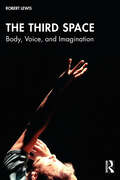- Table View
- List View
Textbook Culture: Pedagogy and Classroom Processes
by Pooja BhallaThis volume captures the essence of schooling in a structural manner and explores the classroom life in the larger schooling context. The emphasis is to uncover the necessary framework of classroom that is significant to understand the place of textbooks in the Indian school education system. By the use of ethnographic vignettes, it brings out the multiple patterns of teacher- student's interactions as they occur in different textbook-based situations. Through this, it sheds light on the primacy of the textbook approach in the classroom processes.The book also investigates the ways through which the students respond to the different pedagogic situations. In doing so, it explores the notions of student boredom, alienation, inclusion and exclusion, and the array of student-textbook experiences that are pivotal to the shape and reshape the classroom processes in the larger pedagogical discourses.This book will be of interest to researchers, students, and teachers of education studies, sociology and politics of education, teacher education, childhood and youth studies, and urban studies. It will also be useful for education policymakers, and professionals in the development sector.
That's My Story!: Drama for Confidence, Communication and Creativity in KS1 and Beyond
by Adam Power-AnnandThe ability to communicate is an essential life skill for all children and young people and it underpins their social, emotional and educational development. If a child experiences a positive relationship with an adult listening carefully, they are more likely to constructively share their thoughts, feelings and their imaginative ideas.That’s My Story! places children’s imagined stories at the heart of their own development and provides a joyful, creative approach to support young children’s personal and social development and to encourage their communication. In this book you will find: Tried-and-tested drama games and activities that support communication and well-being, all adaptable to complement your current practice Guidance and advice on how to promote positive adult-child interactions Examples of creative interventions that support children’s communication development A celebration of the joy that comes with carefully listening to children’s own imagined stories Those of us who work with children can sense a tangible connection between how young children feel and how they communicate. This essential and practical resource will be valuable reading for primary teachers, teaching assistants, speech and language therapists, and drama practitioners, as well as outreach and education departments of theatre companies and other arts organisations.
That's My Story!: Drama for Confidence, Communication and Creativity in KS1 and Beyond
by Adam Power-AnnandThe ability to communicate is an essential life skill for all children and young people and it underpins their social, emotional and educational development. If a child experiences a positive relationship with an adult listening carefully, they are more likely to constructively share their thoughts, feelings and their imaginative ideas.That’s My Story! places children’s imagined stories at the heart of their own development and provides a joyful, creative approach to support young children’s personal and social development and to encourage their communication. In this book you will find: Tried-and-tested drama games and activities that support communication and well-being, all adaptable to complement your current practice Guidance and advice on how to promote positive adult-child interactions Examples of creative interventions that support children’s communication development A celebration of the joy that comes with carefully listening to children’s own imagined stories Those of us who work with children can sense a tangible connection between how young children feel and how they communicate. This essential and practical resource will be valuable reading for primary teachers, teaching assistants, speech and language therapists, and drama practitioners, as well as outreach and education departments of theatre companies and other arts organisations.
Theology and the University
by Fáinche Ryan Dirk Ansorge Josef QuittererTheology and the University presents a compelling argument as to why theology still matters. It considers how theology has been marginalised in the academy and in public life, arguing that doing so has serious repercussions for the integrity of the academic study of religion.The chapters in this book demonstrate how theology, as the only discipline which represents religion from within, provides insight into aspects of religion which are hidden from the social sciences. Against a backdrop of heated debates on the role of the humanities in the university, the book highlights the specific contribution of theological education and research to the work of a university, providing essential information for academic and social/political decision-making. Whilst the book has an emphasis on the Catholic tradition, it explores the prospect of fruitful complementarity and interdisciplinarity both with secularised studies of religion, and other disciplines in the university, such as literature, philosophy, and the social sciences.This book provides orientation for decision-makers, particularly those concerned with the broader question of humanities in the university; students in their choice of study; those interested in the wellbeing of today’s universities; and ecclesial authorities seeking to form leaders capable of intelligent responses to the issues of contemporary society. It is a must read for all researchers of theology, as well as anyone interested in the role of the humanities more broadly.
Theology and the University
Theology and the University presents a compelling argument as to why theology still matters. It considers how theology has been marginalised in the academy and in public life, arguing that doing so has serious repercussions for the integrity of the academic study of religion.The chapters in this book demonstrate how theology, as the only discipline which represents religion from within, provides insight into aspects of religion which are hidden from the social sciences. Against a backdrop of heated debates on the role of the humanities in the university, the book highlights the specific contribution of theological education and research to the work of a university, providing essential information for academic and social/political decision-making. Whilst the book has an emphasis on the Catholic tradition, it explores the prospect of fruitful complementarity and interdisciplinarity both with secularised studies of religion, and other disciplines in the university, such as literature, philosophy, and the social sciences.This book provides orientation for decision-makers, particularly those concerned with the broader question of humanities in the university; students in their choice of study; those interested in the wellbeing of today’s universities; and ecclesial authorities seeking to form leaders capable of intelligent responses to the issues of contemporary society. It is a must read for all researchers of theology, as well as anyone interested in the role of the humanities more broadly.
Theorie beruflicher Didaktik: Philosophische Reflexionen und pädagogische Perspektiven (Pädagogik)
by Ruben Tecklenburg-RapskeWie kann das Fundament einer Theorie beruflicher Didaktik aussehen, die den Anspruch der Prozessorientierung in aller Tiefe und Breite aufnimmt? Ruben Tecklenburg-Rapske verknüpft zentrale Ansätze der Philosophie, Bildungstheorie und Didaktik. Er entwickelt so miteinander verzahnte, modellhafte Vorschläge, die bestehende theoretische Grundlagen ergänzen oder ersetzen. Die pädagogisch didaktische Theorie wird dadurch als eigenständig erfahrungsbezogener Zusammenhang von Begriffen, Urteilen und Schlüssen fassbar, in dem komplexe Themen und Fragen der Berufspädagogik neu diskutierbar sind.
Theorising Public Pedagogy: The Educative Agent in the Public Realm (Routledge Research in Education)
by Karen Charman Mary DixonDrawing on the ideas of Hannah Arendt and Michel Foucault, this book extends the theoretical understanding of public pedagogy and brings into sharp focus the elements that constitute the public realm; the site of public pedagogy. Karen Charman and Mary Dixon offer a new theorisation of the public, a term at the heart of debate in the field, heightened in this post-truth era by the COVID-19 pandemic, the rise of fake news and the technological reconfigurations of public life. The new theorization addresses the ‘public’, ‘pedagogy’ and their confluence in ‘public pedagogy’. The book explores a deep engagement with the architecture and dynamics of pedagogy and argues for the positioning of pedagogy with the public. The authors contribute to a theorisation that re-considers the individual and their capacity for agency within the public realm. The book presents knowledge and pedagogical encounters as key elements of public pedagogy and most significantly, the educative agent as a means of critically rethinking social life and learning in public spaces. Presenting an innovative theoretical approach, this book will be of interest to academics in the fields of public and critical pedagogy and postgraduate students in education, cultural studies and politics.
Theorising Public Pedagogy: The Educative Agent in the Public Realm (Routledge Research in Education)
by Karen Charman Mary DixonDrawing on the ideas of Hannah Arendt and Michel Foucault, this book extends the theoretical understanding of public pedagogy and brings into sharp focus the elements that constitute the public realm; the site of public pedagogy. Karen Charman and Mary Dixon offer a new theorisation of the public, a term at the heart of debate in the field, heightened in this post-truth era by the COVID-19 pandemic, the rise of fake news and the technological reconfigurations of public life. The new theorization addresses the ‘public’, ‘pedagogy’ and their confluence in ‘public pedagogy’. The book explores a deep engagement with the architecture and dynamics of pedagogy and argues for the positioning of pedagogy with the public. The authors contribute to a theorisation that re-considers the individual and their capacity for agency within the public realm. The book presents knowledge and pedagogical encounters as key elements of public pedagogy and most significantly, the educative agent as a means of critically rethinking social life and learning in public spaces. Presenting an innovative theoretical approach, this book will be of interest to academics in the fields of public and critical pedagogy and postgraduate students in education, cultural studies and politics.
Theory and Method in Higher Education Research (Theory and Method in Higher Education Research #9)
by JEROEN HUISMAN AND MALCOLM TIGHTHigher education research is a developing field internationally, which is attracting more and more researchers from a great variety of disciplinary backgrounds within and beyond higher education institutions. As such, it is an arena within which a wide range of theories, methods and methodologies is being applied. This volume of Theory and Method in Higher Education Research explores theories such as student development theory, critical race theory applied to international students, critical language theory and linguistic approaches to higher education research. Additionally, methodological contributions include chapters on quasi-experimental methods, arts-based research and reflective dialogues. Including contributors from Sweden, Finland, Japan, the US, and the UK, the chapter authors present international perspectives on the application and development of theory and methodology in researching higher education.
Theory and Method in Higher Education Research (Theory and Method in Higher Education Research #9)
by Jeroen Huisman Malcolm TightHigher education research is a developing field internationally, which is attracting more and more researchers from a great variety of disciplinary backgrounds within and beyond higher education institutions. As such, it is an arena within which a wide range of theories, methods and methodologies is being applied. This volume of Theory and Method in Higher Education Research explores theories such as student development theory, critical race theory applied to international students, critical language theory and linguistic approaches to higher education research. Additionally, methodological contributions include chapters on quasi-experimental methods, arts-based research and reflective dialogues. Including contributors from Sweden, Finland, Japan, the US, and the UK, the chapter authors present international perspectives on the application and development of theory and methodology in researching higher education.
Theory for Rock & Pop Musicians: A Practical Introduction to Contemporary Music Theory Volume 1
by Adam SaundersAccompanying audio files available on request.
Theory for Rock & Pop Musicians: A Practical Introduction to Contemporary Music Theory Volume 2
by Adam SaundersAccompanying audio files available on request.
The Theory of Educational Technology: Towards a Dialogic Foundation for Design
by Rupert Wegerif Louis MajorEducational technology is controversial – some see it as essential to providing free global learning, others view it as a dangerous distraction that undermines good education. In both instances, most theories that have previously been applied to educational technology do not account for the distinctive nature and vast potential of technology. This book addresses this issue, exploring how education has been bound up with technology from the beginning, and recognising that educational aims have already been shaped by technologies. Offering a ‘dialogic’ theory of educational technology, Rupert Wegerif and Louis Major respond to contemporary challenges to education within this book, including, but not limited to, climate change, misinformation on the internet and the impact of Artificial Intelligence. Chapters introduce, discuss, and contextualise key theories and illustrate through case studies their uses within a diverse range of educational contexts, spanning from primary education to adult lifelong learning. Each chapter also concludes with a short summary, demonstrating how these theories translate to practical implications for design. A fascinating response to current developments in educational technology, this is a crucial read for all involved in creating, researching or making decisions about the use of technologies within educational contexts.
The Theory of Educational Technology: Towards a Dialogic Foundation for Design
by Rupert Wegerif Louis MajorEducational technology is controversial – some see it as essential to providing free global learning, others view it as a dangerous distraction that undermines good education. In both instances, most theories that have previously been applied to educational technology do not account for the distinctive nature and vast potential of technology. This book addresses this issue, exploring how education has been bound up with technology from the beginning, and recognising that educational aims have already been shaped by technologies. Offering a ‘dialogic’ theory of educational technology, Rupert Wegerif and Louis Major respond to contemporary challenges to education within this book, including, but not limited to, climate change, misinformation on the internet and the impact of Artificial Intelligence. Chapters introduce, discuss, and contextualise key theories and illustrate through case studies their uses within a diverse range of educational contexts, spanning from primary education to adult lifelong learning. Each chapter also concludes with a short summary, demonstrating how these theories translate to practical implications for design. A fascinating response to current developments in educational technology, this is a crucial read for all involved in creating, researching or making decisions about the use of technologies within educational contexts.
The Therapeutic Power of the Maggie’s Centre: Experience, Design and Wellbeing, Where Architecture meets Neuroscience
by Caterina FrisoneThis book is about the therapeutic environment of the Maggie’s centre and explores the many ways this is achieved. With an unconventional architecture as required by the design brief, combined with Maggie’s psychological support programme, this special health facility allows extraordinary therapeutic effects in people, to the point that one can speak of therapeutic power.After tracing the story of the Maggie’s centre, the book reveals its fundamentals: Maggie’s Therapeutikos (the-mind-as-important-as-the-body), the Architectural Brief and the ‘Client-Architect-Users’ Triad. It continues by unfolding Maggie’s synergy-that between people and place-which increases users’ psychological flexibility helping them tolerate what was intolerable before. Although comfort and atmospheres are paramount, they are not enough to define the therapeutic environment of the Maggie’s centre. Only by looking at neuroscience that can give us scientific explanations of empathy, feelings and emotions and only considering space neither neutral nor empty, but full of forces that envelop people in an embodied experience, can we explain what generates wellbeing in a Maggie’s centre.The book concludes by critically evaluating the Maggie’s centre as a model to be applied to other healthcare facilities and to architecture in general. It is essential reading for any student or professional working on therapeutic environments.
The Therapeutic Power of the Maggie’s Centre: Experience, Design and Wellbeing, Where Architecture meets Neuroscience
by Caterina FrisoneThis book is about the therapeutic environment of the Maggie’s centre and explores the many ways this is achieved. With an unconventional architecture as required by the design brief, combined with Maggie’s psychological support programme, this special health facility allows extraordinary therapeutic effects in people, to the point that one can speak of therapeutic power.After tracing the story of the Maggie’s centre, the book reveals its fundamentals: Maggie’s Therapeutikos (the-mind-as-important-as-the-body), the Architectural Brief and the ‘Client-Architect-Users’ Triad. It continues by unfolding Maggie’s synergy-that between people and place-which increases users’ psychological flexibility helping them tolerate what was intolerable before. Although comfort and atmospheres are paramount, they are not enough to define the therapeutic environment of the Maggie’s centre. Only by looking at neuroscience that can give us scientific explanations of empathy, feelings and emotions and only considering space neither neutral nor empty, but full of forces that envelop people in an embodied experience, can we explain what generates wellbeing in a Maggie’s centre.The book concludes by critically evaluating the Maggie’s centre as a model to be applied to other healthcare facilities and to architecture in general. It is essential reading for any student or professional working on therapeutic environments.
A Therapist’s Guide to Neurodiversity Affirming Practice with Children and Young People
by Raelene DundonIn this honest and practical guide, autistic therapist Raelene Dundon explores and demystifies how neurodiversity affirming principles can be easily applied to therapeutic practice.Covering essential considerations for working with neurodivergent clients such as presuming competence, promoting autonomy and respecting communication styles, and providing advice on the best affirming approaches in therapy including how to accommodate sensory needs and encourage self-advocacy, Raelene provides easy-to-implement ways to make your practice inclusive and empowering for neurodivergent children and young people.The deficit model is out. It's time to become neurodiversity affirming.
There's a Writer in Our House! Strategies for Supporting and Encouraging Young Writers and Readers at Home
by Ann P. KaganoffThere’s a Writer in Our House! is an invitation to parents of children in first grade through fifth grade interested in actively participating in their children’s early literacy learning from the very first steps.Founded upon well-researched literacy instructional methods that have been informed by the author’s clinical perspective as well as her years of experience with many kinds of learners, this book provides a valuable understanding of how both writing and reading contribute to child development in multiple areas. Chapters provide background concepts regarding grammar and specific critical thinking skills in both writing and reading as well as customizable, child-centered activities used to practice and build writing and reading comprehension skills.You will learn how to advance and encourage your child’s learning and communication skills by highlighting important literacy areas such as vocabulary development, background knowledge, and critical thinking. You will also learn to recognize and track the significant developmental achievements of your child as you proceed from the early to the more complex At-Home activities, as well as receive strategies for how to respond and give feedback in specific situations, such as when a child writes something that makes sense to the child but not to the parent, how to offer feedback that identifies and labels a child’s strengths, and how to collaborate effectively with a child who is just developing new interests or a new willingness to try something that previously seemed “hard.”Practical, accessible, and most importantly, fun, this book is a must-read for all parents, regardless of background, seeking to support their children’s ongoing literacy development confidently and effectively.
There's a Writer in Our House! Strategies for Supporting and Encouraging Young Writers and Readers at Home
by Ann P. KaganoffThere’s a Writer in Our House! is an invitation to parents of children in first grade through fifth grade interested in actively participating in their children’s early literacy learning from the very first steps.Founded upon well-researched literacy instructional methods that have been informed by the author’s clinical perspective as well as her years of experience with many kinds of learners, this book provides a valuable understanding of how both writing and reading contribute to child development in multiple areas. Chapters provide background concepts regarding grammar and specific critical thinking skills in both writing and reading as well as customizable, child-centered activities used to practice and build writing and reading comprehension skills.You will learn how to advance and encourage your child’s learning and communication skills by highlighting important literacy areas such as vocabulary development, background knowledge, and critical thinking. You will also learn to recognize and track the significant developmental achievements of your child as you proceed from the early to the more complex At-Home activities, as well as receive strategies for how to respond and give feedback in specific situations, such as when a child writes something that makes sense to the child but not to the parent, how to offer feedback that identifies and labels a child’s strengths, and how to collaborate effectively with a child who is just developing new interests or a new willingness to try something that previously seemed “hard.”Practical, accessible, and most importantly, fun, this book is a must-read for all parents, regardless of background, seeking to support their children’s ongoing literacy development confidently and effectively.
Think Differently About Learning: A Homeschool Where Children and Parents Thrive
by Maren Goerss Angela SizerHosts of the Homeschool Unrefined Podcast show you how let go of traditional measures of success, and instead measure learning by curiosity, joy, self-regulation, and critical thinking.Children deserve more than the systems we're currently using to educate them. Hardworking teachers, diligent administrators, and devoted parents are trying their best in an outdated system that isn't meeting our children's complex needs. Instead, imagine a different way to learn.With helpful, practical tips and anecdotes from homeschooling families, this guide covers all you need to know about learning differences, mental health, devices and technology, socialization, and more. It's for traditional school families who are learning to balance outer expectations with their own needs with a different way of learning. It's for homeschool families who are looking for a more inclusive, supportive, and authentic approach. Angela and Maren pair their years of teaching in a variety of different schools with their years of homeschooling their combined seven children. As they know first-hand, any parent, child, or family can thrive as they unlearn old ways, lean into their own strengths, and celebrate unconventional wins.
Thinking Geographically: A Guide to the Core Concepts for Teachers
by Alaric MaudeThis book explains how the concepts of geography can teach young people to think geographically, deeply and ethically. Thinking Geographically demonstrates how the concepts of place, space, environment and interconnection teach students new ways of perceiving and understanding the world, the concepts of scale and time teach them ways of analysing the world, while the concepts of sustainability and wellbeing show them how to evaluate and reflect on what they observe, and all eight concepts develop their higher order and critical thinking. To further support teachers, this book includes a chapter on how to teach for conceptual understanding, as well as two chapters that illustrate the application of geographical thinking to an understanding of the effects of land cover change and the problem of regional inequality. Rich with practical examples, this book is an essential resource for geography teachers, whether already teaching or studying to become one, and for those who teach therm.
Thinking Geographically: A Guide to the Core Concepts for Teachers
by Alaric MaudeThis book explains how the concepts of geography can teach young people to think geographically, deeply and ethically. Thinking Geographically demonstrates how the concepts of place, space, environment and interconnection teach students new ways of perceiving and understanding the world, the concepts of scale and time teach them ways of analysing the world, while the concepts of sustainability and wellbeing show them how to evaluate and reflect on what they observe, and all eight concepts develop their higher order and critical thinking. To further support teachers, this book includes a chapter on how to teach for conceptual understanding, as well as two chapters that illustrate the application of geographical thinking to an understanding of the effects of land cover change and the problem of regional inequality. Rich with practical examples, this book is an essential resource for geography teachers, whether already teaching or studying to become one, and for those who teach therm.
Third Millennium Thinking: Creating Sense in a World of Nonsense
by Saul Perlmutter Robert MacCoun John Campbell*Available for pre-order: a definitive guide to thinking clearly in a world full of overwhelming information*__________In our deluge of information, it's getting harder and harder to distinguish the revelatory from the contradictory. How do we make health decisions in the face of conflicting medical advice? How can we navigate the next uncomfortable discussion with family members, who follow completely different experts on climate?In Third Millennium Thinking, a physicist, a psychologist, and a philosopher introduce readers to the tools and frameworks that scientists use to keep from fooling themselves, to understand the world, and to make decisions. We can all borrow from these trust-building techniques that scientists have tested and developed for more than two millennia to tackle problems both big and small.Readers will learn:- How to gain a solid understanding of the facts that shape our modern world- How to navigate through a multitude of possibilities and make informed choices- How to collaborate effectively in tackling the challenges we encounter today- And much moreThrough engaging thought exercises, clear language free from technical jargon, and compelling illustrations drawn from history, everyday life, and insider stories of scientists, Third Millennium Thinking presents a fresh approach for readers to untangle the confusing and make sense of it all.__________'A model of clear thinking, and a terrific discussion of how to use logic and evidence to solve the hardest problems. This might just be the cure for what ails us.' Cass R. Sunstein, Robert Walmsley University Professor, Harvard University, and author of Decisions About Decisions
The Third Space: Body, Voice, and Imagination
by Robert LewisThe Third Space serves a crucial need for contemporary performers by providing an interdisciplinary and physiovocal approach to training. It is a new take on body and voice integration designed to develop the holistic performer. It takes performers through a series of step-by-step practical physiovocal exercises that connects the actor’s centre to the outside world, which increases awareness of self and space. It also develops a deeper connection between spaces within the body and the environment by connecting sound, imagination, and movement.Robert Lewis’s approach is a way of working that unlocks the imagination as well as connecting performers to self, space, and imagination, through voice and body. It conditions, controls, and engages performers by integrating various voice and movement practices.The theories and practice are balanced throughout by: introducing the practical works theoretical underpinnings through research, related work, and case studies of performances; demonstrating a full program of exercises that helps performers get in touch with their centre, their space, and shape both within and outside the body; and exploring the performers physiovocal instrument and its connection with imagination, energies, and dynamics. This book is the result of nearly 20 years of research and practice working with voice and movement practitioners across the globe to develop training that produces performers that are physiovocally ready to work in theatre, screen, and emergent technologies.
The Third Space: Body, Voice, and Imagination
by Robert LewisThe Third Space serves a crucial need for contemporary performers by providing an interdisciplinary and physiovocal approach to training. It is a new take on body and voice integration designed to develop the holistic performer. It takes performers through a series of step-by-step practical physiovocal exercises that connects the actor’s centre to the outside world, which increases awareness of self and space. It also develops a deeper connection between spaces within the body and the environment by connecting sound, imagination, and movement.Robert Lewis’s approach is a way of working that unlocks the imagination as well as connecting performers to self, space, and imagination, through voice and body. It conditions, controls, and engages performers by integrating various voice and movement practices.The theories and practice are balanced throughout by: introducing the practical works theoretical underpinnings through research, related work, and case studies of performances; demonstrating a full program of exercises that helps performers get in touch with their centre, their space, and shape both within and outside the body; and exploring the performers physiovocal instrument and its connection with imagination, energies, and dynamics. This book is the result of nearly 20 years of research and practice working with voice and movement practitioners across the globe to develop training that produces performers that are physiovocally ready to work in theatre, screen, and emergent technologies.

